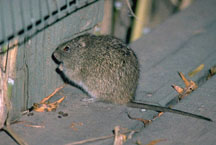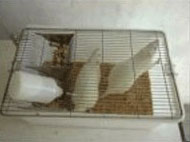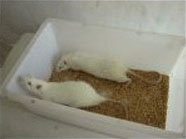There are so many different kinds of rats! On television, we hear about wood rats and kangaroo rats and black rats and Norway rats. In articles about scientific research, we read about Wistar and Fisher and Sprague Dawley rats. Among pet rat owners, we hear about dumbo and rex rats, hairless and berkshire, platinum and tailless. What are these different kinds of rats? How are they related to each other?
In a nutshell, wild rats belong to many different species, while all pet and lab rats belong to a single species called Norway rats (Rattus norvegicus). Norway rats in laboratories may be inbred for many generations to produce strains, which consist of nearly identical individuals which may carry a particular physiological trait of interest. Pet rats are not divided into breeds like dogs or horses, but are loosely organized into varieties or types which are descriptive categories made up of related or unrelated animals possessing one or more physical traits of interest.
Species
Almost all domestic pet rats and lab rats belong to a single species, the Norway rat (Rattus norvegicus). A tiny number of black rats (Rattus rattus) are also kept as pets, but as yet they are extremely rare in the pet trade.
The classic definition of a species is a group of related individuals or populations which are potentially capable of interbreeding and producing fertile offspring.
There are many different species of rodent in the wild that bear the common name "rat." Naked mole rats, wood rats, kangaroo rats, cotton rats, pack rats, and many others are examples of different species.
How are these different species of rats related to each other?
The short answer is: different rat species may not be closely related to each other at all.
The common term "rat" is not a phylogenetic classification (meaning it does not describe a group of closely related species). Rather, "rat" is a common term for rodents that look alike to the casual eye, regardless of ancestry: they are medium-sized rodents with long tails.
|
|
|
Merriam's kangaroo rat (Dipodomys merriami) |
|
|
|
Cotton rat (Sigmodon hispidus) |
Kangaroo rats are only distantly related to Norway rats. They are both rodent species (they belong to the order Rodentia) but that's about all the similarity they share. Kangaroo rats belong to the family Heteromyidae, while Norway rats belong to a different family called Muridae. Norway rats and kangaroo rats aren't that closely related at all. In fact, Norway rats are more closely related to house mice than they are to kangaroo rats, as both rats and mice belong to the same family Muridae. (Here's a quick refresher on animal classification).
Cotton rats are a little more closely related to Norway rats. They belong to the same family Muridae, but cotton rats are in a different genus, called Sigmodon, while Norway rats are in the genus Rattus.
Black rats and Norway rats are even more closely related to each other. They are in the same genus, called Rattus,
but they are different species within this genus. Black rats belong to the species Rattus rattus, while
Norway rats belong to Rattus norvegicus. Norway and black rats aren't the only two species within the genus
Rattus, though -- there are 51 species within Rattus!
Strain
|
|
|
Wistar rats |
|
|
|
Sprague Dawley rats |
Rat strains refer to laboratory rats that have been bred in isolation for generations. A rat strain is created through breeding to produce rats that are similar to each other and can therefore be used in research. Wistar, Fisher, and Sprague Dawley, and their hundreds of internal divisions, are examples of rat strains. (index of major rat strains; rat genome database).
An inbred strain is defined as the product of over 20 generations of brother-sister matings, which results in individuals that are 98% identical to each other. After 40 generations of inbreeding, they are 99.5% similar. In other words, they are almost clones.
Substrains are subdivisions within a strain of rats. Substrains are formed when (1) genetic differences become established in a branch, or (2) when branches are separated between the 20th and 40th generations of inbreeding (between "F20" and "F40"), or (3) when branches are known to have been separated for more than 100 generations (Pass and Freeth 1993)
As an example of a substrain with an established genetic difference, the substrain of Zucker rats is characterized by a faulty leptin receptor in the brain. Leptin is a tiny molecule that binds to receptors in the hypothalamus, causing the rat to feel full. Zucker rats have faulty leptin receptors. Leptin can't bind to the faulty receptor, so Zucker rats never feel full. The result is that Zucker rats eat constantly and become morbidly obese. Zucker rats are used in research as models for obesity, diabetes and heart disease.
Lab rat strain genealogy
Most laboratory rat strains descend from a colony of rats established at the Wistar Institute in 1906. The
Sprague-Dawley strain came from crosses between Wistar females and a "hybrid" male whose origins are unknown.
Long-Evans rats are thought to come from crosses between Wistar females and a wild Norway rat (Pass and Freeth
1993). (Index of major
rat strains, with histories and strain characteristics).
Breed
A breed, according to Webster's Dictionary again, is a group of animals presumably related by descent from common ancestors and visibly similar in most characteristics. A more precise definition of breed is found in Desmond Morris' book Dogs: the ultimate dictionary of over 1,000 dog breeds. According to Morris' definition, a breed is a type of animal that differs from all others of the same species in some way, has a separate history and breed name, and has been breeding true for a number of generations. So, beagle and Doberman are examples of different dog breeds.
According to this definition, there are no separate breeds of rats (yet).
A purebred animal (again according to Webster's) refers to a member of a recognized breed, strain or kind without admixture of other blood over many generations.
So, because there are no separate breeds of rats, there are no purebred rats in the pet world. There are, however, many different strains of rats in laboratories, and a rat from one of those strains could conceivably be called purebred. However, "purebred" is a term that is never used in laboratory rat breeding.
What's the difference between a breed and a strain?
There's obviously some overlap between the two terms: both refer to subgroups of individuals in a given species which share common traits due to common descent. However, the term strain tends to refer to physiological differences, while the term breed tends to refer to morphological differences.
Physiological differences are differences in physical and chemical function, and therefore are often internal and invisible.
Example: a high resistance to cold or heat, a blood clotting disorder, an immunodeficiency, high milk yield (cows), strong wool (sheep) are examples of physiological differencs that may define a strain.
Morphological differences, on the other hand, are differences in form or function, and therefore tend to be external and visible.
Example: body size, leg length, coat color, coat length, tail length, head shape, and ear placement are examples of morphological differences that may define a breed.
Variety
Pet rats are quite variable in appearance -- they may have different colors and markings, their fur may be straight or wavy, they may have no fur at all, their ears may be low-set, they may have long or short or absent tails.
This kaleidoscope of rat variation is loosely divided into varieties or types (e.g. RMCA and AFRMA). A variety is arbitrarily defined as a group of rats that share a single physical trait. For example, rats with curly fur belong to the "rex" variety, rats with low-set ears are called "dumbo," rats without hair are called "hairless."
Two rats belong to the same variety if they share the trait in question, regardless of the rats' ancestry. Also, a single rat may belong to more than one variety, such "dumbo" and "rex."
A variety is therefore a purely descriptive category, it says nothing about the biological relationship between rats.
Describing an individual rat
Norway rats can be bred with many different configurations of traits. Figuring out what category a rat belongs to means tallying up the traits it has and stringing the traits together into a descriptive name.
So, a white rat with a dark brown head and dorsal stripe and curly fur is called a "chocolate hooded rex." This animal is not an exemplar of a breed of chocolate hooded rex rats. He simply displays a particular configuration of traits, which may be quite different from the traits displayed by his parents, siblings and offspring.



